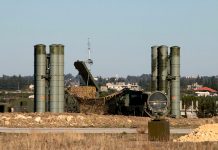
The above image is for illustrative purposes only.
The United Kingdom has made a significant advancement in the development of its next-generation fighter aircraft under the Global Combat Air Program (GCAP). This high-tech collaboration, involving the UK, Italy, and Japan, seeks to revolutionize air combat by combining the aerospace expertise of these three nations. On December 9, 2024, a crucial milestone was achieved when Leonardo, 2Excel, and the UK Ministry of Defence confirmed that the Excalibur flight test aircraft (FTA) had completed its first round of modifications and flight evaluations.
During this phase, the aircraft received important upgrades, including the installation of side and belly-mounted pods to enhance flight stability. The aircraft will now undergo further refinement at Qinetiq’s Boscombe Down facility in Wiltshire, where additional engineering work will be carried out. Excalibur, originally a commercial Boeing 757, is being repurposed as an experimental platform for testing advanced technologies, which will eventually be integrated into the UK’s Future Combat Air System (FCAS).
The GCAP program goes beyond the development of a new fighter jet; it aims to create a comprehensive combat air system that includes unmanned aerial vehicles (UAVs), advanced data and communication systems, and next-generation weaponry. The latest modifications to Excalibur equip it with sophisticated pods capable of carrying advanced sensors, integrated communication systems (ICS), and non-kinetic effects (ISANKE). These components, developed by Leonardo UK in collaboration with international partners, will provide critical data to shape the fighter’s future systems and operational capabilities.
GCAP is one of the most ambitious and significant international collaborations in modern air combat technology. Launched by the UK, Italy, and Japan, the program is designed to create a versatile next-generation fighter aircraft that will not only transform air combat but also support a broader range of combat systems. As global military dynamics evolve, GCAP’s objective is to ensure its partners remain at the cutting edge of aerial warfare, with a platform capable of integrating seamlessly into complex future combat scenarios while countering emerging threats.
The roots of GCAP trace back to the early 2020s when the participating nations recognized the need for a shared, advanced air combat capability. Faced with the high costs and complexities of developing cutting-edge military technology independently, the UK, Italy, and Japan united to achieve their ambitious goals within tight timelines. The collaboration allows each nation to leverage its unique expertise to develop a highly capable and flexible combat air system.
At the heart of the GCAP program is the next-generation fighter aircraft, which will incorporate advanced sensor systems, communication networks, and an array of next-gen weapons. The goal is to design a flexible platform that can execute air superiority, strike, and multi-role operations across various domains, from air to ground to sea. Unlike traditional fighters, the GCAP aircraft will also act as the centerpiece of an integrated combat system, enabling real-time communication with manned and unmanned assets.
The UK, under its Ministry of Defence and aerospace leaders like BAE Systems, is spearheading the development of the fighter’s airframe, avionics, and mission systems. BAE Systems will also play a key role in developing flight control systems and human-machine interfaces, ensuring the fighter’s effectiveness in high-threat environments. Italy, through Leonardo and other partners such as MBDA, will contribute expertise in sensor systems, avionics, and weapons technology, including electronic warfare (EW) and advanced radar systems.
Japan’s contributions focus on advanced stealth, propulsion, and systems integration. Mitsubishi Heavy Industries (MHI) will develop the fighter’s propulsion system, incorporating next-gen engines for superior performance, efficiency, and stealth. Japan’s experience with high-performance radar and sensor fusion systems will also play a critical role in the project.
The fighter will feature revolutionary attributes, including enhanced stealth capabilities across radar and infrared signatures, ensuring it can survive against advanced enemy sensors. It will utilize cutting-edge sensor fusion technology, allowing it to function effectively in a networked combat environment. Equipped with advanced sensors like AESA radars and IRST systems, the fighter will be capable of detecting, tracking, and engaging threats before they can respond.
The weapons suite will include a broad array of air-to-air and air-to-ground missiles, precision-guided munitions, and bombs, offering versatility in both offensive and defensive operations. Additionally, the fighter will be capable of deploying drones and other autonomous platforms, performing dual roles as a manned aircraft and a command-and-control hub for unmanned assets.
The GCAP program is expected to unfold over the next several years, with the first prototype slated for the mid-2020s. By the early 2030s, the goal is to have the next-generation fighter operational, replacing older platforms like the UK’s Eurofighter Typhoon and Japan’s F-2. The participating nations are committed to maintaining a tight timeline to ensure the first squadron of operational aircraft is ready by 2035.
In addition to the fighter, GCAP is focused on creating a broader combat network, including UAVs that will operate alongside the fighter. These UAVs will extend the fighter’s operational range and capabilities, conducting reconnaissance, providing electronic warfare support, and engaging enemy targets. Advanced communication networks will ensure seamless information flow and real-time decision-making across various combat domains.
Looking ahead, GCAP’s integration of AI and machine learning will enable the fighter to make autonomous decisions, enhancing operational flexibility and increasing mission success. The GCAP project promises to reshape combat aviation, setting new standards for the future of air warfare and ensuring the UK, Italy, and Japan maintain a competitive advantage for decades to come.




